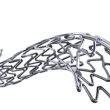Courtesy of Dr. Guillermo Migliaro. In regular clinical practice, overlapping stents are reported in up to 30% of patients undergoing coronary angioplasty, especially due to very long lesions requiring implantation of multiple stents or dissection after the implantation of a first stent. In bare metal stent era, overlapping was associated with unfavorable clinical outcomes<a href="https://solaci.org/en/2017/05/08/promising-outcomes-of-overlapping-stents-in-patients-undergoing-bioresorbable-scaffold-brs-implantation/" title="Read more" >...</a>
Promising outcomes for DEB in long femoropopliteal artery lesions
Courtesy of Dr. Carlos Fava. For type A and B femoropopliteal artery lesions, percutaneous transluminal angioplasty (PTA) with balloon has proven beneficial; however, drug-eluting balloons (DEB) have shown superiority as regards restenosis. Some studies have reported favorable outcomes for DEB in type C and D lesions, but its real benefit is still unclear. This study prospectively<a href="https://solaci.org/en/2017/04/24/promising-outcomes-for-deb-in-long-femoropopliteal-artery-lesions/" title="Read more" >...</a>
Bioresorbable scaffolds with drug-eluting stents: do they entail a higher thrombosis risk?
Courtesy of Dr. Leiva. Bioresorbable scaffolds with drug-eluting stents (bioresorbable vascular scaffolds, BVS) have been added to the list of endovascular treatment options for coronary disease. The ABSORB III trial showed the non-inferiority of this stent type to everolimus-eluting metallic stents as regards target-lesion revascularization (TLR) at one year. However, reports have suggested a higher<a href="https://solaci.org/en/2017/04/21/bioresorbable-scaffolds-with-drug-eluting-stents-do-they-entail-a-higher-thrombosis-risk/" title="Read more" >...</a>
FFR-Guided ACS Revascularization Apparently Superior to Culprit Vessel Treatment
Using fractional flow reserve (FFR) to guide revascularization of all functionally significant lesions in the setting of acute coronary syndrome appears to improve outcomes over treating only the culprit artery, according to the Compare-Acute trial. This study, conducted at 24 centers in Europe and Asia, enrolled 885 patients who were stable following successful primary angioplasty and<a href="https://solaci.org/en/2017/04/11/ffr-guided-acs-revascularization-apparently-superior-to-culprit-vessel-treatment/" title="Read more" >...</a>
DECISION-CTO: Prevailing Questions on CTO Rechanneling
The first and only randomized trial on chronic total occlusion (CTO) revascularization versus optimal medical therapy in stable patients has disappointed interventional cardiologists. According to Dr. Seung-Jung Park, who presented the study, evidence suggests that optimal medical therapy is a reasonable initial treatment strategy for chronic total occlusion, when compared with angioplasty. Critics<a href="https://solaci.org/en/2017/04/08/decision-cto-prevailing-questions-on-cto-rechanneling/" title="Read more" >...</a>
SYNERGY vs. XIENCE in Complex Real-World Patients
Courtesy of Dr. Guillermo Migliaro. Technological advancements in drug-eluting stents (DES) have shown significant improvement as regards the safety and efficacy of these devices. DES are considered to be the golden standard for the treatment of percutaneous coronary interventions. DES with permanent or durable polymers (DP) have been associated with local inflammatory reactions and<a href="https://solaci.org/en/2017/04/01/synergy-vs-xience-in-complex-real-world-patients/" title="Read more" >...</a>
MANTA Closure Device for large-bore arteriotomy closure: Is It Safe?
Courtesy of Dr. Agustín Vecchia. The number of transcatheter aortic valve replacements (TAVR) and the placement of aortic endoprosthesis and ventricular assist devices, among others, have grown exponentially worldwide in the last few years. In a short time, many of these procedures will surely become the new standard of care. Logically, this growth comes hand in hand<a href="https://solaci.org/en/2017/03/27/manta-closure-device-for-large-bore-arteriotomy-closure-is-it-safe/" title="Read more" >...</a>
Critical Limb Ischemia: Wound Blush Is the Most Important Objective
The aim of this study was to find the optimal angiographic endpoint for infrapopliteal interventions to be able to predict wound healing. Evidence shows acceptable patency and successful limb salvage in patients with critical limb ischemia after infrapopliteal intervention. However, the optimal angiographic endpoint remains unclear. Is it enough to restore flow in one<a href="https://solaci.org/en/2017/03/10/critical-limb-ischemia-wound-blush-is-the-most-important-objective/" title="Read more" >...</a>
Is The Transradial Approach Useful in CTO?
Courtesy of Dr. Carlos Fava. The transradial approach has been advanced in time, and is being increasingly used in more and more complex angioplasty procedures with the same benefit, compared to the classical femoral approach. As a result, in many high volume centers, this reality has demoted the femoral approach to a few particular procedures.<a href="https://solaci.org/en/2017/02/25/is-the-transradial-approach-useful-in-cto/" title="Read more" >...</a>
The ReACT Study: Is Angiographic Follow-Up Necessary?
The purpose of this study was to assess the long-term clinical impact of routine angiographic follow-up after coronary angioplasty. Routine angiographic follow-up has been criticized by both clinical and interventional cardiologists for increasing the rate of coronary revascularization due to the “oculostenotic reflex.” This caused a shift in the paradigm for clinical studies, and<a href="https://solaci.org/en/2017/02/17/the-react-study-is-angiographic-follow-up-necessary/" title="Read more" >...</a>









